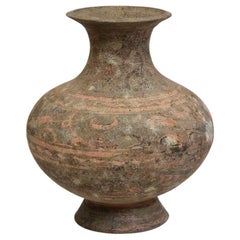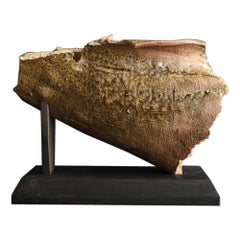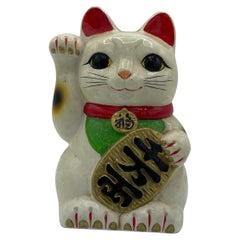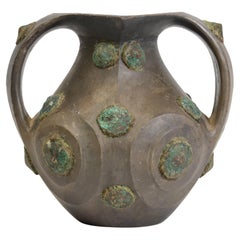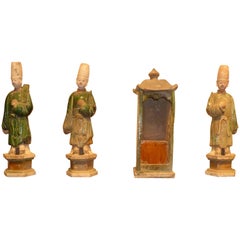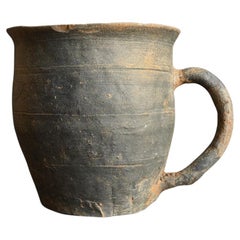Pottery Antiquities
to
27
30
5
183
176
3
4
1
1
1
6,180
723
540
494
286
181
157
82
61
23
183
183
183
Material: Pottery
Han Dynasty, Antique Chinese Painted Pottery Jar
Located in Sampantawong, TH
Antique Chinese painted pottery jar.
Age: China, Han Dynasty, 206 B.C. - A.D.220
Size: Height 28.3 C.M. / Width 25.5 C.M.
Condition: Well-preserved old burial condition overall with...
Category
15th Century and Earlier Chinese Antique Pottery Antiquities
Materials
Pottery
Japanese antique pottery fragments/12th to 13th century/Flower vase
Located in Sammu-shi, Chiba
Tokoname ware is a historic kiln in Japan, where pottery has been made since before the Common Era, and a kiln was established in the 5th century. This kiln is located in Aichi Prefe...
Category
15th Century and Earlier Japanese Other Antique Pottery Antiquities
Materials
Pottery
Japanese Antique Pottery Manekineko Rocking Cat Object 1970s
Located in Paris, FR
This is a vintage piggy bank of manekineko cat. It is made with pottery and it was made around 1970s in Showa era. This cat is rocking object, it is rare than the other manekineko ca...
Category
1970s Japanese Showa Vintage Pottery Antiquities
Materials
Pottery
Han Dynasty, Rare Antique Chinese Pottery Amphora Decorated with Bronze Ornament
Located in Sampantawong, TH
Rare antique Chinese pottery amphora decorated with bronze ornament.
In the past, this kind of vessel was used for wine container.
Age: China, Han Dynasty, B.C. 206 - A.D. 220
Size...
Category
15th Century and Earlier Chinese Antique Pottery Antiquities
Materials
Pottery
Set of Refine Ming Dynasty Green Glazed Attendants and a Sedan Chair
Located in Greenwich, CT
A set of very refined green glazed attendants and one sedan chair, each with benevolent facial expression, beautiful colors and lines, Ming dynasty 1368-1644. Three glazed attendants...
Category
15th Century and Earlier Chinese Ming Antique Pottery Antiquities
Materials
Pottery
Korean antique cup-shaped earthenware/excavated earthenware/hard earthenware
Located in Sammu-shi, Chiba
This is a very old cup-shaped earthenware from Korea.
It was made in a country called "Kaya" located at the southern tip of the Korean peninsula.
This is fired at a kiln temperature ...
Category
15th Century and Earlier South Korean Other Antique Pottery Antiquities
Materials
Pottery
Large Early Tang Dynasty Painted Pottery Model of a Prancing Horse, TL Tested
Located in Austin, TX
A magnificent and large early Tang dynasty (618-906 AD) model of a prancing or dancing horse, circa 7th century.
The majestic animal is caught mid-motion, one leg raised, head grace...
Category
15th Century and Earlier Chinese Tang Antique Pottery Antiquities
Materials
Pottery
Han Dynasty, Antique Chinese Pottery Hu Jar
Located in Sampantawong, TH
Antique Chinese pottery Hu jar decorated with bands of raised lines and a pair of monster masks on the shoulder.
Age: China, Han Dynasty, 206 B.C. - A.D.220
Size: Height 46.6 C.M. /...
Category
15th Century and Earlier Chinese Antique Pottery Antiquities
Materials
Pottery
Guardian(Half human half beast) Pottery Figure, Northern Wei-Tang Dynasty
Located in seoul, KR
This guardian figure represents a fusion of human and beast, a common motif symbolizing protection in Chinese lore. Crafted from pottery, the figure is a testament to the era's sculp...
Category
15th Century and Earlier Hong Kong Han Antique Pottery Antiquities
Materials
Pottery
Two Straw-Glazed Pottery Figures of Court Male and Female, Sui-Tang dynasty
Located in seoul, KR
This pair of straw-glazed pottery figures represents a male and female court attendant, both elegantly attired in period fashion. The female figure wears a flowing robe with draped f...
Category
15th Century and Earlier Hong Kong Tang Antique Pottery Antiquities
Materials
Pottery, Straw
Antique Japanese Sumida Gaia Pottery Pitcher with Elephants
Located in Palm Beach, FL
Lofty antique Japanese pottery pitcher hand crafted in the traditional Sumida Gawa technique having a drip glazed over hand formed elephants on a red background.
Category
Early 20th Century Japanese Anglo-Japanese Pottery Antiquities
Materials
Pottery
Han Dynasty, Antique Chinese Pottery Hu Jar
Located in Sampantawong, TH
Chinese pottery Hu jar decorated with bands of raised lines and a pair of monster masks on the shoulder.
Age: China, Han Dynasty, 206 B.C. - A.D.220
Size: h...
Category
15th Century and Earlier Chinese Antique Pottery Antiquities
Materials
Pottery
$2,800 Sale Price
20% Off
15th Century, Ava, Antique Burmese Pottery Standing Buddha
Located in Sampantawong, TH
Burmese pottery standing Buddha.
Age: Burma, Ava Period, 15th Century
Size: Height 13.4 C.M. / Width 6.2 C.M. / Length 10.7 C.M.
Condition: Nice c...
Category
15th Century and Earlier Burmese Antique Pottery Antiquities
Materials
Pottery
$480 Sale Price
20% Off
Important Chinese Ancient Bronze Money Tree, 25BC-220AD
Located in South Burlington, VT
China, Ancient Bronze “Money Tree” Yaoqian Shu with original pottery base, Han dynasty (25 BCE – 220 CE)
Dimensions: 155cm, 62 inches high
A sculpted terracotta pottery base in the form of a tortoise with attendants and inserted with five individual bronze pole segments with twenty four individual hanging bronze open work money “branches” attached in tiers, four per tier and topped with a figure of a bronze phoenix as apex most bearing varying degrees of malachite and azurite encrustation from ancient burial.
Important Description Details:
Pottery "tortoise" base: 14.5" high and 11" wide
Bronze sections:
7pcs pole bronze sections approximately 8" length each
1pc top "phoenix" bronze section approximately 7" high and 6" wide
20 pcs long bronze hanging wings approximately 10" long and 5" wide each
4 pcs short bronze hanging wings (near top) approximately 7" long and 4" wide each
Total 32 pcs with ancient green and blue azurite patina.
Catalog reference: Schneible Fine arts catalog - 35 Years Collecting Treasures- Number 11p. 28 (see photos)
Provenance: Provenance: Private family collection formerly exhibited “Asia Week” New York City, Fuller Building, Zabriskie Gallery, 2008.
History of money trees:
In the late Han Dynasty tombs...
Category
15th Century and Earlier Chinese Han Antique Pottery Antiquities
Materials
Bronze
$100,000 Sale Price
33% Off
Late Ming Era Documented Glazed Pottery Horse
Located in Kastrup, DK
An elegant Chinese Ming dynasty pottery figurine depicting a horse in a standing pose with polychrome finish (aubergine, light brown and g...
Category
17th Century Chinese Ming Antique Pottery Antiquities
Materials
Pottery
Very old Japanese teapot-shaped pottery "Koseto" / 1200s / Excavated pottery
Located in Sammu-shi, Chiba
This is Seto ware.
Seto is a kiln with a long history located in Aichi Prefecture, Japan (Seto kilns are marked with red circles on the map). It is said to have originated around the 13th century.
In Japan, items from this period of Seto ware are referred to as "Ko-Seto." "Ko" means "old."
This particular item is Ko-Seto, which was fired around the 13th century.
One of the distinguishing features of Ko-Seto, as compared to other kilns, is the presence of glaze. While other kilns produced mostly unglazed pottery, Ko-Seto was covered with ash glaze, giving it a yellowish-green or pale emerald-green color.
In the early Kamakura period (13th century), when Ko-Seto production began, there was increased demand from temples in Kamakura (the capital city of the time, in present-day Kanagawa Prefecture) and the Tokai region for roof tiles, Buddhist ritual objects, and burial urns...
Category
15th Century and Earlier Japanese Other Antique Pottery Antiquities
Materials
Pottery
Pottery Jug from Ancient Holy Land Iron Age c.1000 BC.
Located in Bonita Springs, FL
Ancient Holy Land Iron Age Pottery Jug c.1000 BC.
Fine large pottery footed jug with loop type handle, etched lines at shoulder. Iron Age from the time o...
Category
15th Century and Earlier Israeli Antique Pottery Antiquities
Materials
Pottery
Tang Dynasty, Antique Chinese Painted Pottery Fat Lady with Oxford TL Test
Located in Sampantawong, TH
Antique Chinese painted pottery fat lady with original pigments remaining.
Thermoluminescence (TL) test result from Oxford Authentication Ltd. is included.
Age: China, Tang Dynasty,...
Category
15th Century and Earlier Chinese Antique Pottery Antiquities
Materials
Pottery
Han Dynasty, Antique Chinese Pottery Granary Jar
Located in Sampantawong, TH
Antique Chinese pottery granary jar, with cylindrical shape, decorated with bands of incised lines, and supported by three legs.
Age: China, Han Dynasty, 206 B.C. - A.D. 220
Size: H...
Category
15th Century and Earlier Chinese Antique Pottery Antiquities
Materials
Pottery
Han Dynasty, Antique Chinese Pottery Bowl Support By Three Legs
Located in Sampantawong, TH
Chinese pottery bowl support by three legs.
Age: Chinese, Han Dynasty, B.C. 206 - A.D. 220
Size: Diameter 23.7 C.M. / Thickness 11.7 C.M.
Condition: Well-preserved old burial condit...
Category
15th Century and Earlier Chinese Antique Pottery Antiquities
Materials
Pottery
$880 Sale Price
20% Off
Five Dynasties, Antique Chinese Pottery Lotus Jar
Located in Sampantawong, TH
Chinese pottery lotus jar.
Age: China, Five Dynasties, A.D.907 - 960
Size: Height 24.8 cm. / width 18.2 cm.
Condition: Well-preserved old burial condition o...
Category
15th Century and Earlier Chinese Antique Pottery Antiquities
Materials
Pottery
$1,400 Sale Price
20% Off
Lower Xiajiadian Culture Tripod Li Jar, 2000–1500 BCE
Located in seoul, KR
This tripod jar, dating from 2000 to 1500 BCE, is attributed to the Lower Xiajiadian Culture, which flourished in Northeast China. It exemplifies the early ceramic craftsmanship of N...
Category
15th Century and Earlier Hong Kong Antique Pottery Antiquities
Materials
Earthenware, Pottery
Yuan Dynasty, Antique Chinese Green Glazed Pottery Covered Jar
Located in Sampantawong, TH
Chinese green glazed pottery covered jar.
Age: China, Yuan Dynasty, A.D. 1271 - 1368
Size: height 35 cm / width 25 cm.
Condition: Wel...
Category
15th Century and Earlier Chinese Antique Pottery Antiquities
Materials
Pottery
$1,560 Sale Price
20% Off
Pre-Khmer Pottery Pouring Vessel, Kendi, 6th-8th Century, Cambodia
Located in Austin, TX
An evocative large pottery pouring vessel, kendi, pre-Khmer, 6th-8th century, Cambodia.
The large kendi of typical form, with a bulbous body set on a...
Category
15th Century and Earlier Cambodian Antique Pottery Antiquities
Materials
Pottery
Large Thai Ban Chiang Painted Pottery Vessel, Late Period, circa 300 BC
Located in Austin, TX
A massive Ban Chiang culture painted pottery vessel, circa 300 BC, Thailand.
The large storage jar painted with a bold spiral pattern in red ochre on a b...
Category
15th Century and Earlier Thai Antique Pottery Antiquities
Materials
Pottery
Japanese antique pottery bowl [tokoname ware]/Tokoname ware/12th-13th century
Located in Sammu-shi, Chiba
This bowl is made from Tokoname ware, a type of pottery from Aichi Prefecture. Tokoname ware has a history dating back to the 12th century, and there are still several active kilns t...
Category
15th Century and Earlier Japanese Other Antique Pottery Antiquities
Materials
Pottery
Chinese Siwa Culture Burnished Pottery Jar, 1500 - 1100 BC, China
Located in Austin, TX
A striking Chinese Neolithic to Bronze Age burnished red pottery double handled saddle mouth storage jar, Siwa Culture (circa 1500 to 1100 BC), modern day Gansu Province, China.
...
Category
15th Century and Earlier Chinese Antique Pottery Antiquities
Materials
Pottery
Chinese Pottery Lotus Jar, Five Dynasties, 10th century, China
Located in Austin, TX
A stately Chinese molded, carved, and painted "lotus jar", Five Dynasties and Ten Kingdoms (907 - 979 AD), Dali Kingdom, China.
The elegant vessel of fir...
Category
15th Century and Earlier Chinese Antique Pottery Antiquities
Materials
Pottery
Two Figures of Attendants, Ming Period(1368-1644)
Located in seoul, KR
Statues of attendants crafted from terracotta, featuring glazes in green, Set on rectangular bases.
Period: Ming Dynasty
Medium: Glazed Pottery
Type: Figure
Condition : Excellent(It has soil on it, which is presumed to be evidence of excavation)
Provenance : Acquired in late 1990s from Hongkong
Reference :
1) Indianapolis Museum of Art - Dinastia ming, figure maschili, 1368-1644
(Type : Closely related)
2) V&A Museum - Accession number FE.295:1, 2-2005
(Type : Closely related)
3) Sotheby's 01 May 2007 - The Collection Of Paul Otto Taubert & Jewellery And Decorative Arts - Lot 233
(Price range : 5,000 - 7,000 AUD / Type : Closely related)
4) Asian Art Museum, San Francisco - Object number B60P1631 - Standing Man Tomb Figure
* Ming Dynasty Glazed Pottery Figures
Ming Dynasty glazed pottery figures are renowned for their bold color palette, intricate detailing, and lifelike forms, distinguishing them from earlier traditions. These figures, which depict officials, warriors, animals, and mythical creatures, are characterized by high-gloss lead-based glazes in green, amber, ochre, and sancai (three-color) combinations. The thickly applied glaze pools in recesses, creating depth and enhancing sculptural details. With dynamic postures, expressive facial features, and meticulously rendered drapery, these figures reflect the period’s advancement in ceramic craftsmanship, offering a greater sense of movement and realism compared to the rigid and stylized forms of earlier dynasties.
A defining characteristic of Ming glazed pottery is its elaborate surface detailing, often achieved through raised relief elements and contrasting glazes. Equestrian figures, for example, feature carefully sculpted saddles, harnesses, and decorative embellishments, while human figures are adorned with intricate robes and headdresses. The large scale of these tomb figures, often more imposing than those from previous periods, underscores the increasing importance of funerary art during the Ming era. Unlike later Qing Dynasty figures...
Category
15th Century and Earlier Hong Kong Ming Antique Pottery Antiquities
Materials
Pottery
14th-16th C., A Pair of Antique Sukhothai Pottery Jars with Shell from Shipwreck
Located in Sampantawong, TH
A pair of antique Sukhothai pottery jars with natural shell and barnacle from shipwreck.
Age: Thailand, Sukhothai Period, 14th - 16th Century
Size: Height 26.5 - 26.9 C.M. / Width 1...
Category
15th Century and Earlier Thai Antique Pottery Antiquities
Materials
Pottery
$1,560 Sale Price / set
20% Off
A Gray Pottery Figure of a Horse, Han Dynasty
Located in seoul, KR
This particular horse sculpture exemplifies the typical pose of Han-period equine figures—a neighing steed with its mouth wide open. Like many tomb sculptures of the era, it is crafted in unglazed, with its ears, tail, and legs separately fabricated in wood or clay and slotted into pre-prepared holes. However, several distinguishing features elevate this piece beyond standard Han horse...
Category
15th Century and Earlier Hong Kong Han Antique Pottery Antiquities
Materials
Earthenware, Pottery
Song Dynasty, A Pair of Antique Chinese Pottery Brick Tile with Figures
Located in Sampantawong, TH
A pair of antique Chinese pottery brick tile with figures.
Age: China, Song Dynasty, 10th - 12th century
Size excluding stand: Height 26.5 C.M. / Width 26.5 - 26.8 C.M.
Height inclu...
Category
15th Century and Earlier Chinese Antique Pottery Antiquities
Materials
Pottery
Antique Chinese Neolithic Siwa Culture Pottery Amphora Jar
Located in Sampantawong, TH
Antique Chinese Neolithic Siwa culture pottery Amphora jar.
Age: China, Neolithic period, 1350 B.C.
Size: Height 17.8 C.M. / Width 21 C.M.
Condition: ...
Category
15th Century and Earlier Chinese Antique Pottery Antiquities
Materials
Pottery
Brown-Glazed Moulded Box And Cover, Fujian Kiln, Yuan-Ming Dynasty
Located in seoul, KR
The circular domed cover moulded with a brown glaze that falls short of the straight foot. The pattern on the left features a central circular design with simple shapes and lines car...
Category
15th Century and Earlier Chinese Ming Antique Pottery Antiquities
Materials
Pottery
Chinese Six Dynasties Pottery Model of an Armored Horse, 3rd-4th Century, China
Located in Austin, TX
An extremely rare Chinese painted pottery model of an armored horse, Six Dynasties period (220-581 AD), TL tested by Oxford Authentication.
The stocky ...
Category
15th Century and Earlier Chinese Antique Pottery Antiquities
Materials
Pottery
Pottery Tripod Vessel, Neolithic Period
Located in seoul, KR
The sturdy triangular legs, wide mouth, convex body, and diagonal incised patterns create a harmonious balance, showcasing a form that is both primitive and refined. Notably, the twi...
Category
15th Century and Earlier Hong Kong Antique Pottery Antiquities
Materials
Earthenware, Pottery
Large Cizhou Jar, Yuan Dynasty
Located in seoul, KR
This vase is sturdily potted with a robust ovoid body that rises from a short, spreading foot to a gently tapering neck, finishing with a lipped mouth rim. The exterior is decorated ...
Category
15th Century and Earlier Hong Kong Antique Pottery Antiquities
Materials
Pottery
Rare Yue Celadon Chicken-Head Ewer, Jin-Southern Dynasty
Located in seoul, KR
Chicken-head ewers are among the most distinct and emblematic pottery pieces from the Han (206 BC ~ AD 220) to the Tang dynasties. Their production commenced during the Jin dynasty i...
Category
15th Century and Earlier Hong Kong Han Antique Pottery Antiquities
Materials
Pottery
Ming Period Large Pottery Horse with Saddle (15-16th Century)
Located in seoul, KR
The figure stands on a rectangular base. The horse is depicted in a poised stance, with strong, muscular legs and a slightly bowed head. The mane is carefully sculpted with deep, flowing grooves, adding a dynamic texture to the piece. The head features expressive details, including a well-defined muzzle, flared nostrils. The bridle and harness are delicately painted in faded green, contrasting against the creamy beige body. The saddle is adorned with intricate details, including decorative tassels and a textured pattern, indicative of the elaborate tack used in the Ming period.
Traces of original polychrome pigments in green, black, and ochre remain on the surface, hinting at the sculpture’s once-vibrant appearance. The weathered patina and areas of flaking paint add to its historical authenticity, reflecting centuries of age. The overall craftsmanship and detailing exemplify the Ming Dynasty’s refined ceramic artistry, making this piece a remarkable representation of of asian culture during this period.
Period: Ming Dynasty
Medium: Green, black, and ochre glazed Pottery
Type: Figure
Condition : Good(chips on the upper saddle.)
Provenance : Acquired in late 1990s from Hongkong
Reference : Asian Civilisations Museum - Accession No. C-1384 / 1994-00441 - Ming Dynasty Figure of Horse
(Type : Closely Related)
* Ming Dynasty Glazed Pottery Figures
Ming Dynasty glazed pottery figures are renowned for their bold color palette, intricate detailing, and lifelike forms, distinguishing them from earlier traditions. These figures, which depict officials, warriors, animals, and mythical creatures, are characterized by high-gloss lead-based glazes in green, amber, ochre, and sancai (three-color) combinations. The thickly applied glaze pools in recesses, creating depth and enhancing sculptural details. With dynamic postures, expressive facial features, and meticulously rendered drapery, these figures reflect the period’s advancement in ceramic craftsmanship, offering a greater sense of movement and realism compared to the rigid and stylized forms of earlier dynasties.
A defining characteristic of Ming glazed pottery is its elaborate surface detailing, often achieved through raised relief elements and contrasting glazes. Equestrian figures, for example, feature carefully sculpted saddles, harnesses, and decorative embellishments, while human figures are adorned with intricate robes and headdresses. The large scale of these tomb figures, often more imposing than those from previous periods, underscores the increasing importance of funerary art during the Ming era. Unlike later Qing Dynasty figures...
Category
15th Century and Earlier Hong Kong Ming Antique Pottery Antiquities
Materials
Pottery
Two Yixing Teapots and Covers
Located in seoul, KR
Both Yixing Zisha teapots appear to be modern-Republic era pieces. Yixing Zisha teapots are made from rare Zisha (紫砂) clay, which is exclusively mi...
Category
20th Century East Asian Pottery Antiquities
Materials
Pottery
$1,500 / set
Pair of Rider Figures on Mythical Beasts Possibly from Qing Dynasty
Located in seoul, KR
Identical piece is housed in the Longhai Museum of Zhangzhou City. On October 7, 1989, it was appraised as a third-class cultural relic by the Cultural Relics Appraisal Team of the F...
Category
17th Century Hong Kong Qing Antique Pottery Antiquities
Materials
Pottery
Han Dynasty, A Set of Antique Chinese Pottery Stove
Located in Sampantawong, TH
A set of antique Chinese pottery stove.
Age: Chinese, Han Dynasty, B.C. 206 - A.D. 220
Size: Height 18.5 C.M. / Width 9.8 C.M. / Length 19.4 C.M.
Condition: Well-preserved old buria...
Category
15th Century and Earlier Chinese Antique Pottery Antiquities
Materials
Pottery
Chinese Tang Dynasty Pottery Court Lady
Located in Austin, TX
Painted pottery figure of an opulent Chinese court woman with up-swept hair and standing in a simply draped robe from the Tang Dynasty (618-907 AD). Her beauty is illuminated by the ...
Category
15th Century and Earlier Chinese Tang Antique Pottery Antiquities
Materials
Pottery, Acrylic
14th-16th Century, Sukhothai, Antique Thai Pottery Jar with Shell from Shipwreck
Located in Sampantawong, TH
Sukhothai pottery jar with natural shell and barnacle from shipwreck.
Age: Thailand, Sukhothai Period, 14th - 16th Century
Size: Height 31.6 C.M. / Width 16.8 C.M.
Condition: Ni...
Category
15th Century and Earlier Thai Antique Pottery Antiquities
Materials
Pottery
$1,080 Sale Price
20% Off
Neolithic Pottery Amphora(Gansu Province), 3rd-2nd Millenium BC
Located in seoul, KR
Neolithic Vase with raised neck, slightly flared, two handles. Geometric designs and stylized bovine heads in black. Acquired in Hong Kong in the late 1990s.
Date : 3,000-2,000 BC
M...
Category
15th Century and Earlier Hong Kong Antique Pottery Antiquities
Materials
Earthenware, Pottery
Two Yixing Zisha Teapots and Covers
Located in seoul, KR
Both Yixing Zisha teapots appear to be modern to republic-era pieces. Yixing Zisha teapots are made from rare Zisha (紫砂) clay, which is exclusively...
Category
20th Century East Asian Pottery Antiquities
Materials
Pottery
$1,500 / set
Chinese pottery horse, Han Dynasty (Age Confirmed by Oxford University TL Test)
Located in New York, NY
pigmented pottery horse; provenance: E&J Frankel (New York)
Category
15th Century and Earlier Chinese Antique Pottery Antiquities
Materials
Pottery
Cizhou Lotus Carved Jar, Song-Yuan dynasty
Located in seoul, KR
This jar features a carved design, which is typical of Cizhou ware. It has a creamy white and brown color scheme, and the prominent decoration of lotus flower, which is a common motif in Chinese art and culture, symbolizing purity and enlightenment.
The carving technique involves coating the vessel with a layer of white slip (liquid clay), then carving away parts of it to create the design, revealing the darker clay body beneath. This technique allows for a strong contrast between the background and the carved motif.
Period : Song-Yuan Dynasty
Type : Jar
Medium : Cizhou Ware
Size : 21.5 cm(Height), 11cm(Mouth Diameter)
Provenance : Acquired in 1999, Hongkong
* Cizhou Ware
Cizhou is the name given to a number of stonewares, grey or buff, of varying degrees of hardness, with painted, incised or carved decoration on a clay slip. These stonewares were not only made in the region of Cizhou, Hebei Province, but in several provinces of China during the Song, Yuan and Ming periods. The great centres of production were in the north of China in the provinces of Hebei, Henan and Shanxi.
Cizhou wares seem to have been very popular, made for a clientèle of rich merchants, at a period when the paintings of famous...
Category
15th Century and Earlier Hong Kong Antique Pottery Antiquities
Materials
Pottery
Five Green Glazed Pottery Attendant Figures, Ming Dynasty(1368-1644)
Located in seoul, KR
The three figurines in the back exhibit the typical form of attendants, wearing conical red hats and adopting poses where their right hands are either held in front of their chests o...
Category
15th Century and Earlier Hong Kong Ming Antique Pottery Antiquities
Materials
Pottery
Chinese Pottery Camel, Northern Wei Dynasty (386 - 535 AD), China, TL Tested
Located in Austin, TX
A delightful and rare Chinese painted high fired gray pottery model of a wooly camel, Northern Wei Dynasty (386 - 535 AD), China, with TL test.
The charming camel is portrayed stand...
Category
15th Century and Earlier Chinese Antique Pottery Antiquities
Materials
Pottery
Japanese antique earthenware/Wabi-sabi objects/Unglazed pottery
Located in Sammu-shi, Chiba
I would like to introduce some earthenware with a very interesting shape.
This is an old excavated earthenware from Japan, called "Yayoi" or "Hajiki".
This item is from before the 9...
Category
15th Century and Earlier Japanese Other Antique Pottery Antiquities
Materials
Pottery
China 549-577 AD Northern Qi Dynasty Ancient Caparisoned Horse In Earthenware
Located in Miami, FL
Exceedingly rare Chinese pottery caparisoned horse from the Northern Qi region.
A beautiful sculptural piece, created in China during the Northern Qi dynasty period, between the 549 and 577 AD. This horse statue is extremely finely modeled of earthenware pottery, standing in a very elegant and majestic position striding on a trapezoidal shaped base.
The animal has a gracefully arched neck to the left and its extremely well modeled. The head is adorned with a large detailed tassels of plumes and the body is embellished with a beautiful saddle and intricate harnesses. The trapping around the chest and rump is adorned with elaborated tassels and the straps are accented with multiples florets and bosses in high relief.
The surface is treated with applications of natural pigments such; red, white and others.
Has a measurements of 394 mm by 343 mm by 257 mm (15.53 x 13.52 x 10.15 Inches) (39.4 x 34.3 x 25.7 Cm).
Northern Qi, was the successor state of the Chinese Xianbei state of Eastern Wei...
Category
15th Century and Earlier Chinese Archaistic Antique Pottery Antiquities
Materials
Earthenware, Pottery
$29,988 Sale Price
25% Off
A Large and Rare Straw-Glazed Pottery Amphora, Tang Dynasty
Located in seoul, KR
The ovoid shape suggests the influence from “amphora” of Greece and Rome, while the dragon-shaped handles allude to Persian and Central Asian metalwork. The ubiquitous dragon is a Ea...
Category
15th Century and Earlier Hong Kong Tang Antique Pottery Antiquities
Materials
Pottery, Stoneware
Four Green Glazed Pottery Attendant Figures, Ming Dynasty(1368-1644)
Located in seoul, KR
The first figure wears a short cap and takes a posture as if carrying something on the shoulder, possibly symbolizing a servant or a messenger.
The second figure wears a tall hat and...
Category
15th Century and Earlier Hong Kong Ming Antique Pottery Antiquities
Materials
Pottery
Changsha Bowl from Belitung Ship, Tang Period
Located in seoul, KR
The edges have been dipped in four places with brown, probably iron-oxide. The well of the bowl is freely painted in deep green and coffee coloured brown. These are characteristic fe...
Category
15th Century and Earlier Indonesian Tang Antique Pottery Antiquities
Materials
Pottery
Chinese Tang Dynasty Sancai Glazed Horse and Rider, TL Tested, China
Located in Austin, TX
A fine and unusual Chinese Tang Sancai glazed model of a horse and rider, Tang Dynasty (618 to 906 CE), early 8th century, China.
This fantastic sculpture portrays a male figures se...
Category
15th Century and Earlier Chinese Tang Antique Pottery Antiquities
Materials
Earthenware, Pottery
Large Cocoon-shaped jar with cloud-scroll design, Han Dynasty
Located in seoul, KR
This jar would have served as a mortuary object (mingqi), placed in a tomb as a substitute for the more valuable bronze and lacquer vessels used in daily life. Along with a variety o...
Category
15th Century and Earlier Hong Kong Han Antique Pottery Antiquities
Materials
Pottery
Ming Period Large Pottery Horse with Saddle (15-16th Century)
Located in seoul, KR
This Ming Dynasty painted pottery horse is depicted standing on a tiered rectangular pedestal. The horse has a well-proportioned body, with sturdy legs and a slightly arched neck. The eyes and muzzle are subtly outlined and incised.
The mane is sculpted with deep, parallel grooves. The tail is long and slightly curved left, extending downward. The saddle is prominently featured at the center of the horse’s back, detailed with a raised, rounded seat and an attached stirrup hanging down one side. The saddlecloth is textured with a crosshatch pattern, bordered by a row of carved fringe-like elements. The horse's legs display subtle musculature, and the hooves are clearly defined, with black pigment accentuating their edges.
The original painted pigments, including white, black, and ochre, are still visible, though faded in some areas. The black pigment highlights the mane, tail, and parts of the bridle, while the ochre tones accentuate the saddle and decorative elements.
Period: Ming Dynasty
Medium: Green, black, and ochre glazed Pottery
Type: Figure
Provenance : Acquired in late 1990s from Hongkong
Reference : Asian Civilisations Museum - Accession No. C-1384 / 1994-00441 - Ming Dynasty Figure of Horse
(Type : Closely Related)
* Ming Dynasty Glazed Pottery Figures
Ming Dynasty glazed pottery figures are renowned for their bold color palette, intricate detailing, and lifelike forms, distinguishing them from earlier traditions. These figures, which depict officials, warriors, animals, and mythical creatures, are characterized by high-gloss lead-based glazes in green, amber, ochre, and sancai (three-color) combinations. The thickly applied glaze pools in recesses, creating depth and enhancing sculptural details. With dynamic postures, expressive facial features, and meticulously rendered drapery, these figures reflect the period’s advancement in ceramic craftsmanship, offering a greater sense of movement and realism compared to the rigid and stylized forms of earlier dynasties.
A defining characteristic of Ming glazed pottery is its elaborate surface detailing, often achieved through raised relief elements and contrasting glazes. Equestrian figures, for example, feature carefully sculpted saddles, harnesses, and decorative embellishments, while human figures are adorned with intricate robes and headdresses. The large scale of these tomb figures, often more imposing than those from previous periods, underscores the increasing importance of funerary art during the Ming era. Unlike later Qing Dynasty figures...
Category
15th Century and Earlier Hong Kong Ming Antique Pottery Antiquities
Materials
Pottery
Japanese Antique Tsubo pot Flower Vase Wabi-Sabi
Located in Chiba, Chiba
This is an old Japanese vase.
It is old but in good condition with no cracks or chips.
We will always suggest the best shipping method.
Please contact us first.
We also introduce m...
Category
19th Century Japanese Antique Pottery Antiquities
Materials
Pottery
Green and Ochre Glazed Altar Table with Offerings, Ming Dynasty, 15~16th Century
Located in seoul, KR
The table bearing pig head, rice cakes, dishes of meat, fish and fruit. Known as Mingqi, these terracotta models were customarily included in Chinese burial practices, particularly among the affluent, to aid the deceased in their journey through the afterlife. This tradition extends back to the Neolithic Period. A unique terracotta funeral table...
Category
15th Century and Earlier Hong Kong Ming Antique Pottery Antiquities
Materials
Pottery
Recently Viewed
View AllMore Ways To Browse
Large Chinese Celadon Pots
Khmer Torso
Ancient Luristan Bronze
Chinese Terracotta Army Warriors
Cloisonne Pots Bonsai Trees
Greco Bactrian
Han Dynasty Amphora
Han Dynasty Court Lady
Palanquin Handles
Sancai Phoenix
Schist Gandharan Buddha
Bactrian Stone
Chinese Coconut Cup
Han Dynasty Chinese Cocoon Jar
Han Dynasty Cocoon Jars
Han Dynasty Pig
Khmer Goddess
Kojima Shoten
